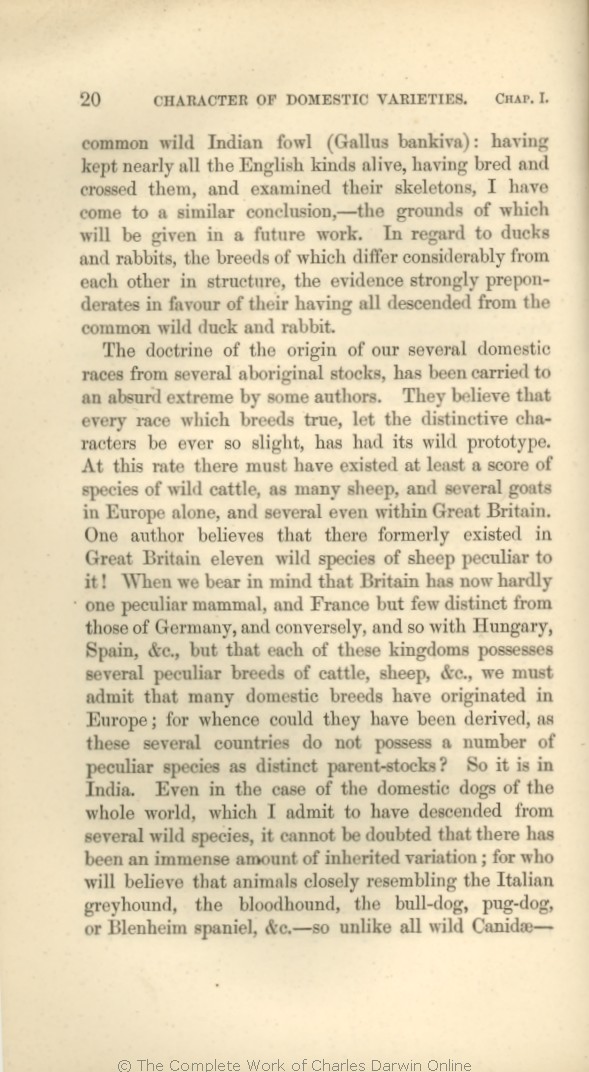common wild Indian fowl (Gallus
bankiva): | bankiva): 1866 | | bankiva). 1859 1860 1861 |
| having 1866 | | Having 1869 1872 |
| kinds 1866 |
| breeds of the fowl 1869 1872 |
| I have come to a similar conclusion, — the grounds of which will be given in a future work. 1866 |
| it appears to me almost certain that all are the descendants of the wild Indian fowl, Gallus bankiva; and this is the conclusion of Mr. Blyth, and of others who have studied this bird in India. 1869 1872 |
| the 1859 1860 1861 1866 | | some 1869 1872 |
| considerably 1859 1860 1861 1866 | | much 1869 1872 |
| other 1859 1860 1861 1866 | | other, 1869 1872 |
| in structure, the evidence strongly preponderates in favour of their having all 1866 |
| in structure, I do not doubt that they all have 1859 |
| in structure, I do not doubt that they have all 1860 |
| in structure, the evidence preponderates in favour of their having all 1861 |
| the evidence is clear that they are all 1869 1872 |
|
The doctrine of the origin of our several domestic races from several aboriginal stocks, has been carried to an absurd extreme by some authors. They believe that every race which breeds true, let the distinctive characters be ever so slight, has had its wild prototype. At this rate there must have existed at least a score of species of wild cattle, as many sheep, and several
goats | goats 1859 1860 1861 1866 | | goats, 1869 1872 |
| in Great Britain 1859 1860 1861 1866 1869 |
| OMIT 1872 |
| it! 1859 1860 1861 1866 1869 | | Great Britain! 1872 |
| hardly 1859 1860 1861 1866 1869 | | not 1872 |
| Germany, 1866 1869 1872 | | Germany 1859 1860 1861 |
| conversely, and 1859 1860 1861 1866 1869 | conversely, and 1872 |
| have 1859 1860 1861 1866 1869 | | must have 1872 |
| could 1859 1860 1861 1866 | | have 1869 | | otherwise could 1872 |
| have 1859 1860 1861 1866 1872 | have 1869 |
| derived, 1859 1860 1861 1866 1869 | | derived? 1872 |
| as 1859 1860 1861 1866 1869 | as 1872 |
| these 1859 1860 1861 1866 1869 | these 1872 |
| several 1859 1860 1861 1866 1869 | several 1872 |
| countries 1859 1860 1861 1866 1869 | countries 1872 |
| do 1859 1860 1861 1866 | | could 1869 | do 1872 |
| not 1859 1860 1861 1866 1869 | not 1872 |
| possess 1859 1860 1861 1866 1869 | possess 1872 |
| a 1859 1860 1861 1866 |
| so large a 1869 |
| OMIT 1872 |
| number 1859 1860 1861 1866 1869 | number 1872 |
| of 1859 1860 1861 1866 1869 | of 1872 |
| peculiar 1859 1860 1861 1866 1869 | peculiar 1872 |
| species 1859 1860 1861 1866 1869 | species 1872 |
| as distinct 1859 1860 1861 1866 | as distinct 1872 | | for 1869 |
| parent-stocks? 1859 1860 1861 1866 1869 | parent-stocks? 1872 |
| domestic dogs 1859 1860 1861 1866 1869 | | breeds 1872 |
| whole 1859 1860 1861 1866 1869 |
| domestic dog throughout the 1872 |
| ..... 1861 1866 1869 1872 | | fully 1859 1860 |
| to have 1861 1866 1869 | | have probably 1859 1860 | | are 1872 |
| it 1861 1866 1869 1872 | | I 1859 1860 |
| be doubted 1861 1866 1869 1872 | | doubt 1859 1860 |
| variation; 1861 1866 1869 1872 | | variation. 1859 1860 |
| for who will 1861 1866 1869 1872 |
| Who can 1859 1860 |
| pug-dog, or 1861 1866 1869 1872 | | or 1859 1860 |
|









